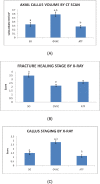The effects of alpha-tocopherol supplementation on fracture healing in a postmenopausal osteoporotic rat model
- PMID: 23018307
- PMCID: PMC3438250
- DOI: 10.6061/clinics/2012(09)16
The effects of alpha-tocopherol supplementation on fracture healing in a postmenopausal osteoporotic rat model
Abstract
Objective: Osteoporosis increases the risk of bone fractures and may impair fracture healing. The aim of this study was to investigate whether alpha-tocopherol can improve the late-phase fracture healing of osteoporotic bones in ovariectomized rats.
Method: In total, 24 female Sprague-Dawley rats were divided into three groups. The first group was sham-operated, and the other two groups were ovariectomized. After two months, the right femora of the rats were fractured under anesthesia and internally repaired with K-wires. The sham-operated and ovariectomized control rat groups were administered olive oil (a vehicle), whereas 60 mg/kg of alpha-tocopherol was administered via oral gavage to the alpha-tocopherol group for six days per week over the course of 8 weeks. The rats were sacrificed, and the femora were dissected out. Computed tomography scans and X-rays were performed to assess fracture healing and callus staging, followed by the assessment of callus strengths through the biomechanical testing of the bones.
Results: Significantly higher callus volume and callus staging were observed in the ovariectomized control group compared with the sham-operated and alpha-tocopherol groups. The ovariectomized control group also had significantly lower fracture healing scores than the sham-operated group. There were no differences between the alpha-tocopherol and sham-operated groups with respect to the above parameters. The healed femora of the ovariectomized control group demonstrated significantly lower load and strain parameters than the healed femora of the sham-operated group. Alpha-tocopherol supplementation was not able to restore these biomechanical properties.
Conclusion: Alpha-tocopherol supplementation appeared to promote bone fracture healing in osteoporotic rats but failed to restore the strength of the fractured bone.
Conflict of interest statement
No potential conflict of interest was reported.
Figures




References
-
- Consensus Development Conference. Prophylaxis and treatment of osteoporosis. Am J Med. 1991;90(1):107–10. - PubMed
-
- Albright F, Smith P, Richardson A. Postmenopausal osteoporosis: Its clinical features. J Am Med Assoc. 1947;116:2465–74.
-
- Kanis JA, Johnell O, Oden A, Sembo I, Redlund-Johnell I, Dawson A, et al. Long-term risk of osteoporotic fracture in Malmo. Osteoporosis international: a journal established as result of cooperation between the European Foundation for Osteoporosis and the National Osteoporosis Foundation of the USA. 2000;11(8):669–74. - PubMed
-
- National Osteoporotic Foundation. 2025 osteoporosis prevalence figures: state by state report. January 1997. Women's Health Matters. 1998;2(30):1.
Publication types
MeSH terms
Substances
LinkOut - more resources
Full Text Sources
Medical

